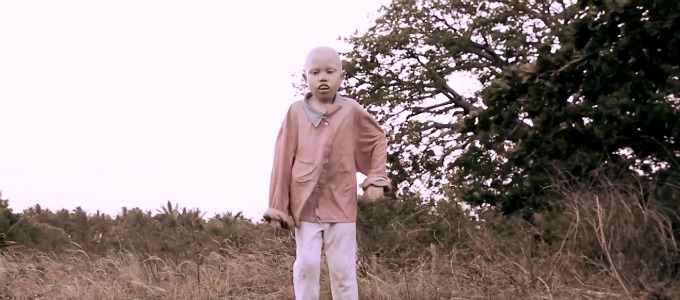 A film by Noaz Deshe, WHITE SHADOW has been hailed as an exemplar of visceral filmmaking. It tells the story of Alias, an albino boy in Tanzania, as he is hunted by local witch doctors. After his family is attacked, Alias is forced to move to the city, with new companions in new surroundings. Eventually, however, the circumstances of his new environment prove to be no less cruel than his last, and he finds himself on the run once again.
A film by Noaz Deshe, WHITE SHADOW has been hailed as an exemplar of visceral filmmaking. It tells the story of Alias, an albino boy in Tanzania, as he is hunted by local witch doctors. After his family is attacked, Alias is forced to move to the city, with new companions in new surroundings. Eventually, however, the circumstances of his new environment prove to be no less cruel than his last, and he finds himself on the run once again.
In some ways, the film itself is as harsh as the story it’s trying to tell. Deshe adopts a style specifically adapted to bring the audience as close to the characters as possible. Almost every shot is close and intimate. In lighter moments, a smile can fill up the screen. For the majority of the film, however, it seems claustrophobic and invasive. Every bead of sweat or nervous twitch of an eye is highlighted and magnified. It’s well-executed, and contributes enormously to the generally uncomfortable feel of the film.
The story itself is deliberately obscure, the narrative unforgiving. New characters are introduced without explanation, and occasionally they disappear again just as quickly. Many of the people in Alias’s life are a blur for the first half of the film, and only he himself remains constant. It’s a mostly effective device: we watch the film from Alias’s eyes, so it makes sense that we are as much in ignorance as he is. It also lends itself well to the story’s unrelenting tension, never pausing to let the audience catch up. Shadowy motivations and tangled alliances are commonplace, with some not unravelled until the end of the film, and a few not even then.
On the other hand, it can be a frustrating experience to be constantly behind the curve. The lack of explicit characterisation, too, can be confusing. Beyond the trauma that Alias suffers at the beginning of the film, we don’t really get to know what he’s like as a person until about a third of the way through. Before that, he is a mostly blank slate. This leaves a risky gap in which – despite his omnipresence – the audience may fail to emotionally connect with the central character, in a film where emotional connection is everything.
This is not a world devoid of contentment – it exists, but Alias is simply not part of it.
Even once we properly get to know Alias, the scene shifts can still be dizzying, and it can be easy to miss the significance of certain scenes. Throughout WHITE SHADOW there is a pervasive and overwhelming air of the unknown, unfamiliar and hostile. Smiles and laughter are few and far between, and once again this works wonders in invoking a certain empathy in the audience. Any act of kindness breaks our hearts, whereas an act of cruelty or indifference becomes usual fare. Subtle effects like these are often used to simulate the experience of being isolated and ostracised, and the film succeeds magnificently in doing so. Here and there we even get glimpses of families, colleagues and friends, laughing happily in the sunshine or revelling in the nightlife. This is not a world devoid of contentment – it exists, but Alias is simply not part of it.
The film’s approach to violence is especially interesting, as much of it is not directly shown. We catch only snippets as fists plunge downwards, or a machete flickers into view. Instead, sound fills the key role vacated by vision. The thud of a fist or the tearing of flesh galvanises the viewer’s imagination into providing its own substitutes for the images, producing terror and horror in equal measures. It’s this technique that is the driving force between most of the film’s most harrowing scenes, and epitomises WHITE SHADOW as a work of art: brutal and uncompromising. As a unique by-product, witnessing the threat of violence possesses an equal impact to witnessing the act itself. Few other films can claim to produce such an influence.
In one of the film’s most touching scenes, Alias and Salum (another albino boy) play together, alone in the underbrush. Their japes begin with games universally loved by young children – regardless of age or nationality – as they pick up sticks and alternate between firing at each other, dodging imaginary explosions. But then their fantasies take on a slightly more mundane turn, as they fill out job applications for fictional companies. It’s in this moment that we realise those two simple things are equally as fantastical from their point of view. It’s wonderfully done, artfully reminding us just how far albino children are removed from our reality, and how dramatically different their lives are from ours.
Not everything in the film is quite so finessed. Memories from Salum and Alias’ friendship are interspersed between scenes throughout the film, which at times can make it very difficult to hold onto the narrative. Occasionally half the content of these scenes are undermined by the need to work out how it relates to the previous one, which has the end effect of distracting from the story. The significance of the film’s last few moments are also less than clear, which can once again be a frustrating experience for those now heavily invested in Alias’s story. Ultimately, however, they are minor flaws. WHITE SHADOW is a cinematic gut punch which is dedicated and confrontational in its portrayal of the plight of albinos. Even though it’s a work of fiction, its basis in real-life events gives it a horrifying and heart breaking gravity that remains unspoiled.
WHITE SHADOW is now available to view on Curzon Home Cinema – click here.
httpvh://youtu.be/JiMMpu86zCo

